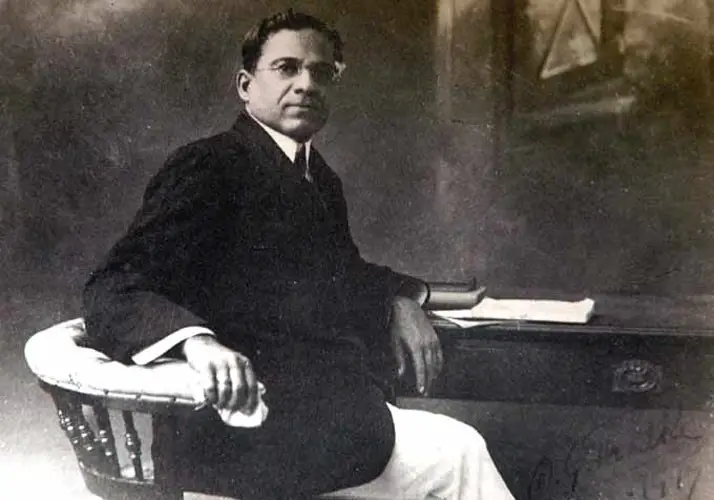
Dhundiraj Govind Phalke, screen name Dadasaheb Phalke was born on the 30th of April 1870 at Trimbak, Bombay Presidency. He is a British Indian (currently Maharashtra, India). Dadasaheb is from a family of nine, his father, Govind Sadashiv Phalke alias Dajishastri, was a Sanskrit professor, and he also worked as a Hindu priest conducting religious ceremonies, his mother, Dwarkabai, was a housewife. He has two brothers Shivrampant who is twelve years older than him. He was the chief administrator of the princely state of Jawhar before his death, and Raghunathrao served as a priest before he died. Likewise, he also has three sisters. Dadasaheb was a prominent screenwriter, film producer, film director, editor, costume designer, and makeup artist who is married to Saraswatibai and has three children (Mandakini Athavale, Vrinda Pusalkar, and Bhalchandra Phalke).
He completed his primary school in Trimbakeshwar in, 1885 he went to J. J. School of art, where he studied drawing for a year, he later furthered into Kala Bhavan, the Faculty of Fine Arts, at the Maharaja Sayajirao University of Baroda, where he completed a course in oil painting and watercolor painting in 1890. Dhundiraj Govind Phalke started his film production career thanks to film producer, director, and screenwriter Cecil Hepworth of Walton Studios. Through the recommendations of Mr. Cabourn. Hepworth allowed Phalke to visit all departments in his studio and put him through their work and the film demonstration. On the advice of Cabourn and Hepworth, he purchased the Williamson film camera for fifty pounds and ordered a raw Kodak film and a perforator. Phalke spent two months in London and returned to India on 1st April 1912.
Then started the Phalke Films company that same day. After his return, he relocated with his family from the Ismail building to Charni Road (Mathura Bhavan Bungalow) in Dadar. Where he constructed a showroom at the compound of the bungalow and organized a dark room, and made plans for processing the film, he as-well Imported filmmaking equipment from London. His first film production was a short movie Ankurachi Wadh (Growth of a Pea Plant) because, of the movie he got recognized by investors like Yashwantrao Nadkarni and Narayanrao Devhare, who offered Dhundiraj a loan. After his first short film, he wrote and produced his second-length film based on the legends of Harishchandra. He created flyers online and print casting for actors and crews for the movie. His eldest son Bhalchandra acted as Rohidas, son of Harishchandra and Taramati. Phalke was in charge of the direction, production design, makeup, editing, and film processing and Trymbak B.Telang was the cameraman.
The film was completed in six months and 27 days. After the success of Raja Harishchandra, Dadasaheb moved to Nasik, where he wrote and produced other films such as Nala, Mohini Bhasmasur, and
Satyavan Savitri
Satyavan-Savitri is a Marathi-language television >> Read More...
 , the films were successful like the first one. With the tremendous response to the movies, he was able to pay off his investors and buy more film equipment. He left for London in August for his film’s primer, where he got offers from different companies, including Cecil Hepworth made him an offer to stay back and establish his career in England due, to some difficulties, he left for India before the contract could be sealed. As technology advanced, Dadasaheb couldn’t keep up, and he gradually faded off from the entertainment world.
, the films were successful like the first one. With the tremendous response to the movies, he was able to pay off his investors and buy more film equipment. He left for London in August for his film’s primer, where he got offers from different companies, including Cecil Hepworth made him an offer to stay back and establish his career in England due, to some difficulties, he left for India before the contract could be sealed. As technology advanced, Dadasaheb couldn’t keep up, and he gradually faded off from the entertainment world.
Before retiring, he produced the movie Setubandhan which was released in 1932 and later released with dubbing. From 1936 to 1938, his last film was Gangavataran (1937), and it was a massive success for Dadasaheb before he relocated back to Nashik. He died on the 16th of February 1944. His struggles and success stories in the entertainment industry earned him the title father of Indian cinema. He was honored by the government in 1969 with the Dadasaheb Phalke award for his contribution to the film industry. In his honor, a postage stamp was made and was released by India post in 1971. In 2001, a lifetime achievement award was given from the Dadasaheb Phalke Academy in Mumbai.
LATEST NEWS
WEB STORIES
LATEST SERIALS & SHOWS
LATEST WEB SERIES
LATEST PHOTOS
ACTRESS PHOTOS
LATEST ARTICLES
OTHER PRODUCERS
BORN TODAY